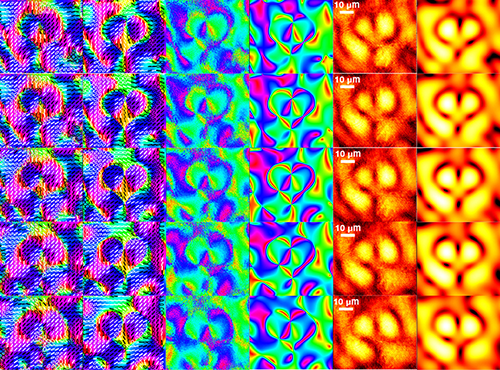| Jul 13, 2021 |
Harnessing the dark side
(Nanowerk News) When we think about singularities, we tend to think of massive black holes in faraway galaxies or a distant future with runaway AI, but singularities are all around us. Singularities are simply a place where certain parameters are undefined. The North and South Pole, for example, are what’s known as coordinate singularities because they don’t have a defined longitude.
|
 |
| The singularity engineering procedure was also applied to creating more exotic singularities, such as a polarization singularity sheet. Here, the polarization properties (e.g. polarization azimuth, ellipticity angle, and intensity) of the experimental structured light field is compared to the numerical predictions. (Image: Daniel Lim/Harvard SEAS) (click on image to enlarge)
|
|
Optical singularities typically occur when the phase of light with a specific wavelength, or color, is undefined. These regions appear completely dark. Today, some optical singularities, including optical vortices, are being explored for use in optical communications and particle manipulation but scientists are just beginning to understand the potential of these systems. The question remains — can we harness darkness like we harnessed light to build powerful, new technologies?
|
|
Now, researchers from the Harvard John A. Paulson School of Engineering and Applied Sciences (SEAS) have developed a new way to control and shape optical singularities. The technique can be used to engineer singularities of many shapes, far beyond simple curved or straight lines. To demonstrate their technique, the researchers created a singularity sheet in the shape of a heart.
|
![Cross-section of a designed heart-shaped phase singularity sheet]() |
| Cross-section of the designed heart-shaped phase singularity sheet. The extended dark region in the center image is a cross-section of the singularity sheet. The phase is undefined on the singularity sheet. (Image: Daniel Lim/Harvard SEAS)
|
|
“Conventional holography techniques are good at shaping light, but struggle to shape the darkness,” said Federico Capasso, the Robert L. Wallace Professor of Applied Physics and Vinton Hayes Senior Research Fellow in Electrical Engineering at SEAS and senior author of the paper. “We have demonstrated on-demand singularity engineering, which opens up a vast set of possibilities in wide-ranging fields, from super-resolution microscopy techniques to new atomic and particle traps.”
|
|
The research is published in Nature Communications ("Engineering phase and polarization singularity sheets").
|
|
Capasso and his team used flat metasurfaces with precisely-shaped nanopillars to shape the singularities.
|
|
“The metasurface tilts the wavefront of light in a very precise manner over a surface so that the interference pattern of the transmitted light produces extended regions of darkness,” said Daniel Lim, a graduate student at SEAS and first author of the paper. “This approach allows us to precisely engineer dark regions with remarkably high contrast.”
|
![Metasurfaces, which are nanostructured surfaces containing shapes like nanopillars (left) and nanofins (right)]() |
| Metasurfaces, which are nanostructured surfaces containing shapes like nanopillars (left) and nanofins (right), were employed to realize these singularity structures experimentally. The above image shows scanning electron microscope images of titanium dioxide nanostructures that were used to precisely shape the wavefront of light in producing the singularity sheets. (Image: Daniel Lim/Harvard SEAS)
|
|
Engineered singularities could be used to trap atoms in dark regions. These singularities could also improve super high-resolution imaging. While light can only be focused to regions about half a wavelength (the diffraction limit) in size, darkness has no diffraction limit, meaning it can be localized to any size. This allows darkness to interact with particles over length scales much smaller than the wavelengths of light. This could be used to provide information on not only the size and the shape of the particles but their orientation as well.
|
|
Engineered singularities could extend beyond waves of light to other types of waves.
|
|
“You can also engineer dead zones in radio waves or silent zones in acoustic waves,” said Lim. “This research points to the possibility of designing complex topologies in wave physics beyond optics, from electron beams to acoustics,” said Lim.
|



